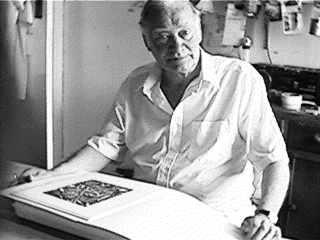| INTRODUCTION
by Hilary Chapman |
|
For over thirty years James
Bostock combined an artistic career with that of a full-time teacher
and administrator. Notwithstanding his academic commitments, as well
as the inevitable demands of bringing up a family of three boys, Bostock
produced a remarkable oeuvre of paintings and prints. The process
of cataloguing the seventy or so wood engravings, as well as the intaglio
prints, lithographs and illustrative work has been a revelation (not
least to the artist himself) of the breadth of subject matter and
variety of style these prints demonstrate. It was at the Royal College of Art in the I 930s, under the influence of such tutors as Edward Bawden, Eric Ravilious and Paul and John Nash that Bostock first became attracted to printmaking, and especially wood engraving. After distinguished war service he began to produce wood engravings which were soon recognised fortheir fine craftsmanship and artistic individuality. By 1950 he had been elected a member of both the Royal Society of Painter-Etchers and Engravers (later the Royal Society of Painter-Printmakers) and the Society of Wood Engravers. He exhibited regularly at the annual exhibitions of these societies and his work was often included in the Royal Academy summer shows. Museums and international institutions acquired his wood engravings and Bostock quietly secured his position within the print world.  However, it was not until retirement in 1978, and a resultant flurry of artistic activity, that James Bostock's work came before a wider audience. Exhibitions of his paintings and prints occurred regularly and the wood engravings were shown at the exhibitions of the newly invigorated Society of Wood Engravers, which was now fostering a growing interest in the medium. Bostock was able to promote not only his many earlier works, but also the results of a productive decade. Sadly, by 1988, deteriorating eyesight and the onset of arthritis caused him to cease wood engraving - although, even then, he still painted and drew with vigour. The wood engravings continued to be shown at exhibitions and, in 1996, Bostock was one of nineteen major artists to be included in an exhibition arranged by Hilary Paynter (Chairman of the Society of Wood Engravers) at the Bankside Gallery, London. This exhibition featured artists who were members of both The Royal Society of Painter-Printmakers and the Society of Wood Engravers. Bostock had no impressions left of his most popular prints and Hilary Paynter kindly offered to print some of these blocks for him. She is full of admiration for the deep cutting and quality of the artist's blocks and described them as 'a joy to print'. Only a year later Bostock's work was included in Hal Bishop's landmark exhibition at Exeter Museum, Twentieth-Century British Wood Engraving: A Celebration... and a Dissenting Voice. This exhibition received an Arts Council award and is possibly the most important display of British wood engraving to occur in recent years. James Bostock acknowledged fulsomely the generosity and genuine interest that Hal Bishop has shown in promoting his work Indeed a solo exhibition of Bostock's watercolours and prints was curated by Hal Bishop at Exeter Museum in the Following year In order to show the full range of his artistic output. A substantial and distinguished group of collectors has now been established to, James Bostock's wood engravings who admire not only the technical skill of his prints but their humour, observation and stylistic variety. This catalogue has been produced to record and reproduce these prints. It could not have been completed without the artist's generous help and kindly co-operation which has been much appreciated. - Hilary Chapman. November 2002. The artist adds |